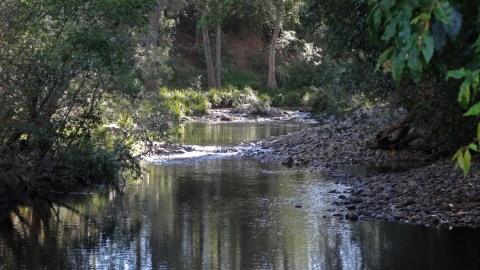As outlined in the Methodology for bioregional assessments of the impacts of coal seam gas and coal mining development on water resources (the BA methodology; Barrett et al., 2013), anthropogenic or ecological receptors are defined as:
A discrete attribute or component of a water-dependent asset that may be measurably impacted by a change in water quantity or quality resulting from coal seam gas or coal mining development.
This has since been refined to enhance subsequent applications of the BA methodology (see companion submethodology M02 (as listed in Table 1) for compiling water-dependent assets (Mount et al., 2015)) and the working definition adopted throughout this submethodology is:
A receptor is a point in the landscape where water-related impacts on assets are assessed.
Receptors are inventoried in a receptor register. Receptors are linked to assets in the water-dependent asset register (product 1.3 (description of the water-dependent asset register); see Table 2 for product details). They have a number of attributes associated with them, including an identifier and location (latitude and longitude coordinates). Information and data can be recorded at a receptor including depth-related information, such as watertable depth, modelled water pressure at specific depths and asset (aquifer) depths. A receptor will not normally be a biological entity (e.g. a bird, frog or plant); rather it must represent key characteristics of the landscape class or asset class it is located within such as the habitat of biological entities. For example, the groundwater-dependent habitat for a biological entity is the asset, rather than the biological entity itself. A receptor can be conceived of as a long thin imaginary line projecting from the centre of the Earth out through the location coordinate (latitude and longitude).
A primary role of a receptor in a bioregional assessment (BA) is that it is the point location in the landscape where detailed information about the responses to changes in the water regime is summarised, including an assessment of the uncertainty in those responses. In practice, receptors are typically located within landscape classes and linked to water-dependent assets. They are where estimates (i.e. parameters, state variables and/or fluxes) from surface water and groundwater models are related to potential impacts (hazards) on water-dependent assets arising from additional coal resource development in the coal resource development pathway (CRDP).
Examples of receptors might include nodes in a river model or points within groundwater or rainfall-runoff models where uncertainty in hydrological response variables can be assessed. Receptors might also be associated with existing physical monitoring points; receptors might include:
- streamflow and water quality gauge points
- surface water access entitlements
- groundwater bores
- existing environmental monitoring or sampling points
- nodes in a river routing model
- groundwater model pixel x,y centroids
- remotely sensed pixel centroids
- rainfall-runoff model pixel x,y centroids
- any other point that may be sensibly interpolated from the preceding information.
Receptors are the focal point for receptor impact models (see companion submethodology M08 (as listed in Table 1) about receptor impact modelling) and these will have one or more hydrological response variables and one or more receptor impact variables associated with them. While the detail of defining and selecting the hydrological response variables and receptor impact variables is dealt with in other submethodologies, it is necessary to consider them, at least conceptually, when applying this submethodology to ensure the receptors are suitable for use with the receptor impact modelling. The receptor impact models and the qualitative models that support them are the primary mechanism for determining direct or indirect impacts, and subsequent cumulative impacts of coal resource development.
Hydrological response variables and receptor impact variables will vary by landscape class and impact type and their selection is guided by the relevant conceptual models. When applying this submethodology it is necessary, in every BA, to at least relate the receptors to the landscape classes and the assets using the process defined in Section 3.2 and Section 3.3. The landscape classes are documented in product 2.3 (conceptual modelling) (see Table 2 for BA product details).
There is an important point to clarify. The hydrological modelling, in some cases, might report results at model nodes that might not coincide with receptor locations. In these cases, hydrological changes will be interpolated to receptor locations for use in subsequent receptor impact modelling and impact and risk analysis.

METHODOLOGY FINALISATION DATE
- 1 Background and context
- 2 Defining receptors
- 3 Assigning receptors
- 3.1 Overview of process for assigning receptors
- 3.2 Landscape classification
- 3.3 Process for assigning receptors across the landscape
- 4 Developing a receptor register
- References
- Datasets
- Glossary
- Citation
- Acknowledgements
- Contributors to the Technical Programme
- About this submethodology
